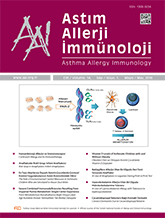


Objective: Asthma is a disease that occurs in genetically susceptible individuals who are exposed to allergens. It is currently impossible to change our genetic code. Elimination of environmental risk factors that play an important role in the emergence of asthma may help control asthma symptoms. The aim of this study was to investigate the role of environmental control measures in asthmatic children who are sensitized to house dust mites.
Materials and Methods: The study included of 64 asthmatic children aged 7-16 years who had applied to Bulent Ecevit University School of Medicine`s child allergy and immunology polyclinic. To evaluate the role of environmental control measures on asthma control, we performed home visits to observe the patients` houses and their environment and the patients were given a questionnaire form of 39 questions about environmental conditions where the child lived and an asthma control questionnaire consisting of 7 questions.
Results: The asthma was controlled well in 51 children (79.6%) and poorly in 13 (20.3%). Duration of disease, gender, frequency of doctor visits, economic situation and living conditions of the family, presence of pets, cleaning conditions, heating type and instant relative humidity of the house, regular use of medications, cigarette exposure, flu vaccination, and presence of concomitant diseases to asthma in the family were not different between the groups. There was also no difference between two groups in terms of the presence or absence of carpets in the house and in the room of asthmatic children. The maternal education level was statistically significantly different between the two groups (p=0.023), whereas the paternal education level not (p=0.133).
Conclusion: Environmental control measures to control asthma in children who are sensitized to house dust mites are a significant issue to consider. Successful control and prevention of asthma needs a comprehensive approach including education, cleaning, housing features and maintaining these practices.